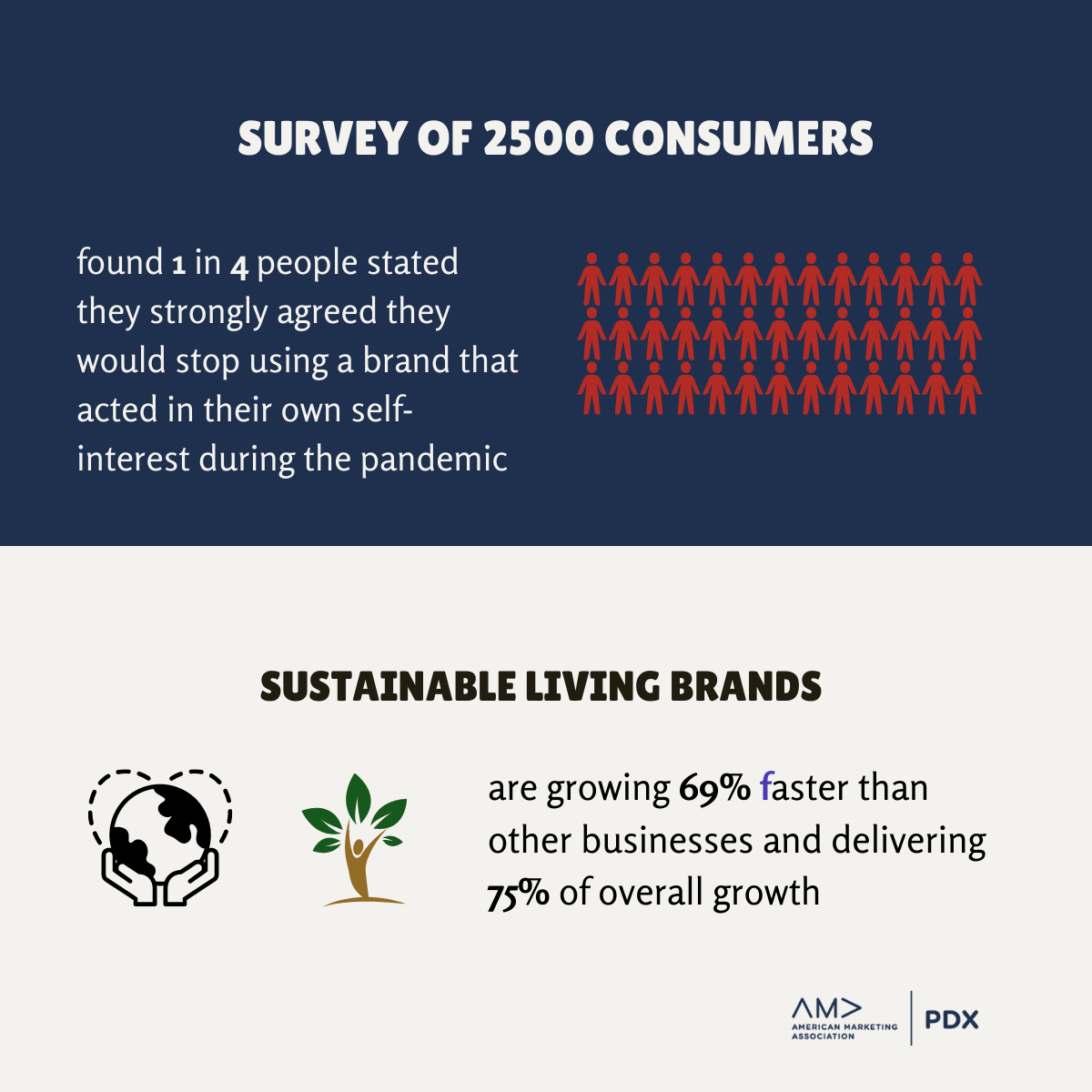5 Tips Marketers Should Consider Post-Pandemic
Perhaps the biggest pivot during the COVID pandemic has been the reliance on technology at all levels of business. Be it meetings with top executives of companies or consultations with potential customers, managing volunteer projects like AMA PDX Agency, or navigating local events from speed networking to huge conferences like AMA PDX’s Marketing Excellence Awards – we all had to rely on technology and people navigating it. Other changes included the way businesses took orders, as websites often became the preferred way of consuming products and services as customers finding themselves on phone lines received long waiting times. The values of brands also came under new scrutiny in the light of global emergencies. This taught marketers a lot of lessons, many that should remain even as the world slowly opens back up.
Businesses Must Remember Purpose and Identity
The businesses most successful during the COVID 19 pandemic were those companies that had a strong sense of who they were, what purpose they had, and who they were best able to serve. Companies that could clearly demonstrate to their customer base not only what they were about but how their particular brand helped out at a time of need fared better than those that couldn’t. For example, if a boot manufacturer understood that their type of products was used by first responders and then donated them, this likely resonated with customers.
In fact, one survey about 2021 global marketing trends states that 79% of consumers remembered instances when brands responded in positive ways to the pandemic.
Goodwill and Sustainability
A brand that understands its purpose and will continue to promote goodwill and charity towards communities, as well as their own employees, after the pandemic is over will likely benefit. Surveys show that consumers retained the most brand awareness of the companies that were perceived to protect their employees. Furthermore, sustainable-living brands are growing 69% faster than other businesses and are, overall, delivering 75% of overall growth. In contrast, when consumers perceive a brand is working in opposition to these values, these customers are more likely to pursue another brand. A survey of 2,500 global consumers found that one in four people stated they strongly agreed that they had stopped using brands they felt acted in their own self-interest during the worldwide pandemic.
Reconsider Your Social Media Campaign
Despite its relative newness, social media is already transitioning for younger generations. For instance, while Generation Z is more likely to engage in online product reviews than Boomers or even Gen X, they are also eschewing Facebook – a driving campaign for many businesses – in favor of Instagram and TikTok. To get this population’s attention on social media, companies should leverage platforms in a more creative way than before. Companies should consider changing their social media campaigns to rely less exclusively on Facebook and more on the platforms that encourage creativity. Traditional wisdom for social media posting has always been an easy formula – a third sales, a third informational, and a third fun and creative. Because of the type of platforms Gen Z frequents, consider varying that formula and instead, rely on more fun and non-sales-driven content. Gen X and Boomers will likely follow. Generational shifts often are precursors to cultural changes. Leveraging these newer platforms will mean your business is on the ground floor of such shifts.
Taking Advantage of a Gig Economy
During the COVID-19 lockdowns, many companies utilized the gig economy for the first time. That means, companies contracted out their work to temporary and flexible freelance talent with specialized expertise. Companies in the midst of the global pandemic found themselves in need of new skillsets that may not have been available with their current employees. On the other hand, workers with specialized expertise found themselves with talents being needed in multiple industries. By contracting out to these workers, brands found themselves able to fulfill all their needs efficiently. In turn, contracted workers found themselves satisfied with the multiple work opportunities. In fact, a survey of talent that had started working in the gig economy that utilized their area of expertise found 57% of them to be satisfied or highly satisfied with their work.
Humanity Over Efficiency
When emergencies hit, a company’s first reaction may be to increase the efficiency of production at all costs as its number one priority. However, this may not be the most strategic for profits and survival. The truth is, the idea of community resonates better with a brand’s image than efficiency.
Surveys suggest that almost four in five people remembered a brand that positively contributed to the pandemic, and one in five stated they would be much more loyal to that brand. Simply put, the charitable response was much more effective to reach long-term goals and profits, and this should be kept in mind long after the world has reopened to post-pandemic levels.
Post Written By: Stefanie Wich-Herrlein
Experienced marketing and communications professional with a passion for travel and a 10-year track record in creating print, online & social media content, managing communication projects, and developing marketing strategies for various industries. Initially from Germany, lucky enough to call Portland, Oregon, her new home away from home.
Communications Specialist | Visual Storyteller | Social Media & Content Marketing
Director of Content Marketing at AMA PDX







